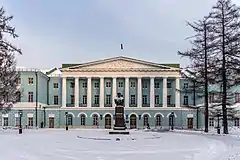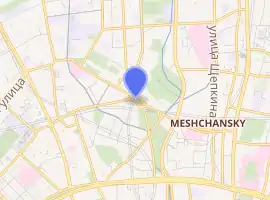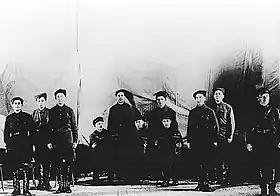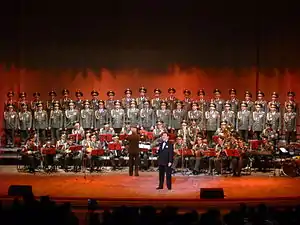Central House of Officers of the Russian Army
The Mikhail Frunze Central House of Officers of the Russian Army (Russian: Центральный дом Российской армии имени Михаил Фрунзе, ЦДСА) also known formerly as the Cultural Center of the Russian Armed Forces (Russian: Культурного центра Вооруженных Сил Российской Федерации) is a Russian cultural center and cultural heritage site of the Russian Army located on Suvorov Square, Moscow. The center is designed to meet the spiritual, educational and cultural needs of servicemen and civilian personnel of the armed forces.[1]
| Central House of Officers of the Russian Army | |
|---|---|
Центральный дом Российской армии | |
 The cultural center in the wintertime. | |

| |
| Former names | House of Red Army |
| General information | |
| Architectural style | Neoclassical |
| Address | Suvorov Square |
| Town or city | Moscow |
| Country | Russia |
| Coordinates | 55°46′53″N 37°36′56″E |
| Completed | 1779 |
| Inaugurated | 23 February 1928 |
| Owner | Russian Defense Ministry |
| Design and construction | |
| Architect | Dmitry Ukhtomsky |
History

In 1758, in the territory of what is today Suvorov Square, the country estate of Count Vladimir Semyonovich Saltykov was built. In 1802, the building which now houses the cultural center was home to the newly established Moscow School of the Order of St Catherine.[2] The Revolutionary Military Council in late September 1927 decreed the formation of the Central House of the Red Army in order to meet the cultural needs of military personnel and their families. The center was officially established the following February and was granted the honorific "Mikhail Frunze". Many famous military ensembles and creative teams were formed in the premises. On 12 October 1928, the Alexandrov Ensemble (then known as the Song Ensemble of the M. V. Frunze Red Army Central House) was formed out of the central house as its official artistic group. In the pre-war period, the following cultural/musical units were established in the officers' house:
- Russian Army Theatre
- Red Army Band (now the Central Military Band of the Ministry of Defense)
- Central Chess Club
- Red Army and Navy Museum (1928–1965)
The officers house also sponsored CSKA Moscow and impacted its development directly until 1953.[3]
During the Great Patriotic War, the CDKA worked as a propaganda center for the Soviet Armed Forces, providing materials were made for political workers and other propagandists. Many of the civilian and military personnel at the officers house were deployed to the front lines in Eastern Europe to perform for troops serving on the Eastern Front of the war. Over 900 military units received concert touring groups over the course of the four year eastern front of the war. After the war, at the end of 1946, under the administration of Sergey Barabashov, the Red Army House was renamed to honor the more modern Soviet Army. The Central House continued to function as the head and largest cultural and educational army center in the country. The building reached its peak of excellence in the 1960s and 1970s, when classes of the Moscow State Art and Cultural University took place at the House of Officers. At the time, it was under the direct control of the Main Political Directorate of the Soviet Armed Forces.
In 1993, the house was renamed to reflect the Russian Federation's newly acquired status as an independent nation. In 1997, the name was changed to the Cultural Center of the Armed Forces of the Russian Federation. By order of Minister of Defence Sergey Shoygu in June 2016, the name of the building was reverted to its historical name.[4]
Current condition and tasks

The Central House of the Russian Army is a state budgetary institution under the direct control of the Russian Defense Ministry. To date, the house remains the main military cultural institution and methodological center of the army. Its employees actively participate in the entertainment of entire military units. As of 2017, there are about 20 clubs operating at the CSRA. Since 2017, the Central House of Officers has been headed by Vasily Mazurenko.[5]
The building is commonly utilized on any public holiday in Russia.[6] In Soviet times, the house served as a place to honor recently deceased members of the Soviet government and the Central Committee of the Communist Party. State funeral ceremonies for Yuri Gagarin, Georgy Zhukov, Konstantin Rokossovsky, Ivan Konev, as well as Alexei Kosygin all took place in the house. The use of the house for these events were minimal, due to its status being lower than the House of the Unions during state funerals. These events have not been held there since 1989.
Halls
The following concert halls function in the Central House of the Russian Army:[7]
- The Red Banner Hall is a ceremonial reception room for guests, accommodating up to 600 guests.
- The Fireplace Room seats up to 120 people and usually hosts meetings of senior Russian officers.
- The Concert Hall has seating capacity of 400–600 and hosts concerts of visiting Russian military bands. It is equipped with modern lighting and sound equipment.
- The Malachite Living Room is designed for 100 guests.
- The Golden Living Room has a small capacity of about 20 people.
- The Red Living Room is intended for official meetings, musical events and can accommodate up to 80 people.
- The White Living Room is designed for small receptions of up to 100 people.
- The Chamber Hall can accommodate up to 200 guests.
References
- https://moscow.arttube.ru/institution/Cultural-center-of-the-Armed-Forces-of-the-Russian-Federation-named-after-M-V-Frunze_en/
- Иван Гарбузов. "Суворовская площадь". Я узнаю Москву. Retrieved 2019-05-29.
- "История ансамбля песни и пляски Российской Армии им. Александрова". Echo of Moscow. 2016-12-25. Retrieved 2019-05-29.
- "История". Центральный Дом Российской Армии им. М.В. Фрунзе. 2017. Retrieved 2019-05-29.
- "Leadership". Центральный Дом Российской Армии им. М.В. Фрунзе. 2017. Retrieved 2019-05-29.
- "Центральный Дом Российской Армии им. М.В. Фрунзе". Министерство обороны Российской Федерации. 2017. Retrieved 2019-05-29.
- "Наши залы". Центральный Дом Российской Армии им. М.В. Фрунзе. 2017. Archived from the original on 2017-06-11. Retrieved 2019-05-29.